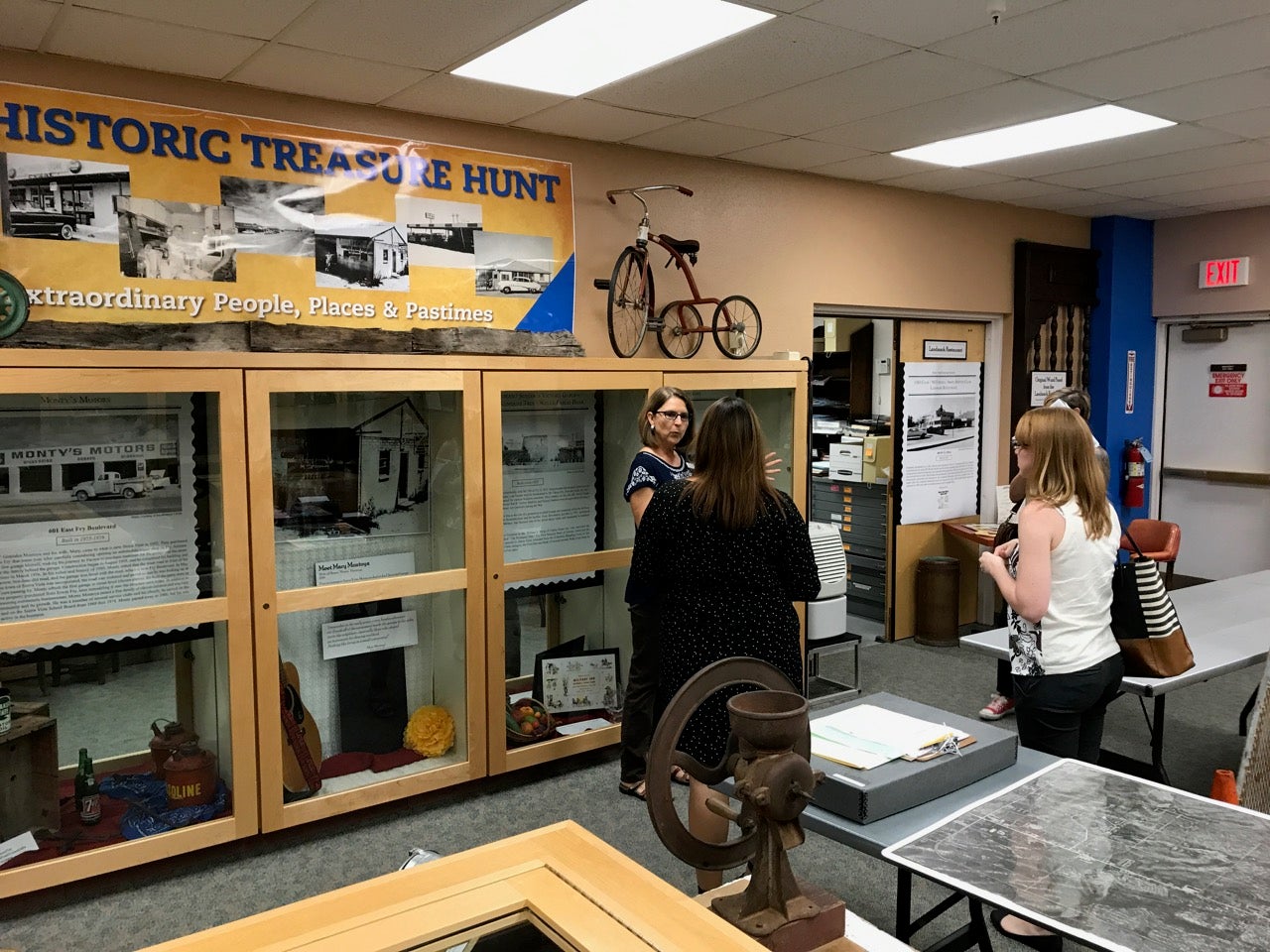How often do you think about water? You may be told to conserve water or drink more of it, but do you know where it all comes from?
Water/Ways is part of the Museum on Main Street (MoMS) program — a national/state/local partnership to bring Smithsonian exhibitions and programs to cultural organizations in rural communities of 50,000 residents or less. The exhibit will be transported to 12 rural communities around Arizona starting in 2018.
Water/Ways is part of the Smithsonian’s Think Water Initiative to raise awareness of water as a critical resource for life through exhibitions, educational resources and public programs. It will explore the endless motion of the water cycle, water’s effect on landscape, settlement and migration, and its impact on culture and spirituality. It looks at political and economic efforts to ensure access to water, and explores how human creativity and resourcefulness provide new ways to protect water resources and renew the public’s relationship with the natural environment.
Arizona Humanities, the Walton Sustainability Solutions Initiatives and Arizona State University's School of Historical, Philosophical and Religious Studies (SHPRS) will work together to expand the research and resources of the exhibit.
The state scholar for the project is Paul Hirt, professor of history in SHPRS and senior sustainability scholar for the Julie Ann Wrigley Global Institute of Sustainability. He has written extensively on the relationship between natural resources and civilizations and was drawn to the project by a desire to educate Arizona citizens.
“This is another opportunity to educate the public about the challenges we face, of the importance of water and to try and help make us more intelligent managers of the resources in our world that support our lives,” Hirt said. “Our imbalance between supply and demand is very serious and very problematic and we have to get a handle on it. Just explaining to people that there is an imbalance between the supply and demand is an important first step in solving it.”
Hirt taught a public history class this fall, where his students got first-hand experience in helping build the exhibit. They developed professional skills by working with the communities that will be hosting Water/Ways.
Students visit one of the host sites in preparation of the exhibit.
“What ASU is doing is working with 12 communities and finding out what their local water story is and helping them develop ideas for interpretation and helping develop ideas for public programming,” Hirt said. “It’s been a really exciting and rewarding experience to everyone involved.”
Daniel Milowski, a doctoral student studying history in Hirt’s class, is involved in helping the rural host sites with foundational research that will allow them to excel in planning and hosting Water/Ways.
“The work that I am doing is a lot of research and documentation on the various host sites that we’re working with, so building up a large library of information and resources that can be used to create local exhibits that can be paired with the national travelling exhibit,” Milowski said. “We are researching cultural resources like musicians, music recordings, books that have been written creating a sense of cultural resources and others like that.”
The main exhibit from the Smithsonian will tell the water story at the national level while the sites that host the exhibits will work with state partners to develop a water story at a local level. This allows each site to create a unique exhibit that will not be seen anywhere else.
“It’s a very timely exhibit for Arizona in particular because water, access to water and water resources is essentially what makes Arizona work,” Milowski. said “It’s something that all Arizonans will benefit from knowing more about.”
The exhibit will serve as a place to convene community conversations about water’s impact on American culture. Each host site will develop complementary exhibits, host public programs and facilitate educational initiatives to raise people’s understanding about what water means culturally, socially and spiritually in their own community.
“Each site's exhibit will be different but with the same focus on state and local water stories,” said Abbie Harlow, a master’s degree student studying history who was in Hirt’s class. “Water is immensely important to regions across Arizona and a focus on water use and conservation can benefit everyone.”
The students and faculty from ASU are just a handful of people working to bring the exhibit to Arizona.
“There are many scholars and local experts on water who will lend their expertise through research, teaching and speaking,” said Brenda Thomson, the executive director of Arizona Humanities. “Each community brings unique partners to host programs and events with local schools, businesses and museums. So this is a major undertaking.”
All involved hope Water/Ways will bring a new understanding of water to the communities as they each focus on their own stories and concerns. With so much happening in the world today and in our world of constant information, the exhibit brings up fundamental questions that may be overlooked.
The team collaborates on the best points for the exhibit.
“Will we thrive or perish, and what will the earth look like if we don't understand and preserve the planet's water?” Thomson asked. “The exhibition helps us explore the inseparable story of water and humanity and the impact of the choices we make today on the planet and the species which inhabit the earth.”
There is a reason water is central to life on earth. For thousands of years it has been the cause of war, prosperity and stories which contribute to our society today. However, many people no longer see how water affects their lives and the world around them. Water/Ways is working to bring water back into the conversation of culture.
“It is viewed as destructive, creative, mythological, essential and much more,” Thomson said. “Man tries to control water through dams, canals, irrigation and yet water claims and reclaims land through rain, snowfall, floods and forests turn to fields, farms, mines and wetlands in the path to sustainability, an urgent priority. The subject of water is complex and intriguing and relevant to all of us. The Water/Ways exhibition should not be missed.”
The public can participate in the conversation on social media with hashtags #thinkWater and #waterwaysAZ. Water/Ways will be touring throughout the state for two years starting in June 2018. Below are the host sites and the days the exhibit will be on display.
Bisbee Mining & Historical Museum
June 2–July 15, 2018
Bisbee, AZ
Fort Apache and Theodore Roosevelt School National Historic Landmark
July 28–Sept. 9, 2018
Fort Apache, AZ
Bullion Plaza Cultural Center and Museum
Sept. 22–Nov. 4, 2018
Miami, AZ
McFarland State Historic Park
Nov. 17–Dec. 30, 2018
Florence, AZ
Henry F. Hauser Museum
Jan. 12–Feb. 25, 2019
Sierra Vista, AZ
Amerind Museum
March 9–April 21, 2019
Dragoon, AZ
Central Arizona College – Aravaipa Campus
May 4–June 16, 2019
Winkelman, AZ
Carl Hayden Visitor Center at Glen Canyon Dam
June 29–Aug. 11, 2019
Page, AZ
Camp Verde Community Library
Aug. 24–Oct. 6, 2019
Camp Verde, AZ
Tubac Presidio State Historic Park
Oct. 19–Dec. 1, 2019
Tubac, AZ
Cañon Elementary School District 50
Dec. 14, 2019–Jan. 26, 2020
Black Canyon City, AZ
The Lake Havasu Museum of History
Feb. 8–March 22, 2020
Lake Havasu City, AZ
Top photo: Colorado River. Photo by Charlie Leight/ASU Now
More Environment and sustainability

Majority of American religious leaders silently believe in climate change, ASU study shows
Many Americans turn to religious leaders for guidance on matters of faith and morality.With this in mind, a new study, led by a researcher from Arizona State University, suggests that congregations…

A prototype of a university for a thriving world
The challenges for our world’s health and the future of humanity and other life-forms command urgency — and the university is accelerating its wide-reaching collaborative work to help keep the planet…

From K–12 to corporate upskilling, ASU guides learners of all ages to design a sustainable future
Editor’s note: This story is part of a series exploring how ASU tackles complex problems to create a thriving future.When Kennedy Gourdine was a high school student in Maryland, she conducted…





